HARTING experts explain what you should consider when choosing an Ethernet connector for industrial market and commercial applications.
Goda Inokaityte, Senior Product Specialist, and Arnold Tchiegne Wandji, Senior Product and Application Manager, HARTING
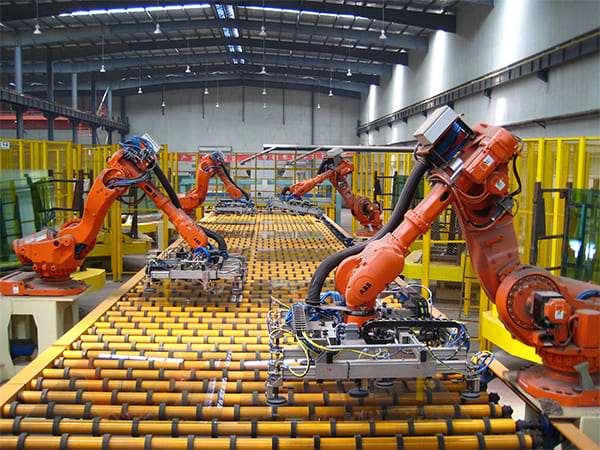
In 1970, Norman Abramson, a professor at the University of Honolulu, sought to create a cheap communication solution for university locations on various neighboring islands. His solution, ALOHAnet, was a communication protocol that randomly fired data packets over two frequency bands to avoid collisions, and it later became the foundation for today’s Ethernet connectivity protocols. Today, Ethernet serves as the primary communication standard for international industrial production. Without it, the industrial market as we know it would simply not exist.
As this market continues to evolve, the enabling technologies behind the expansion of Industry 4.0 — including automated equipment, the Internet of Things (IoT), the Industrial Internet of Things (IIoT) — require faster, more powerful, and more efficient Ethernet infrastructures capable of rapidly and accurately transmitting ever greater amounts of data in as little physical space as possible. These demands have made rugged and reliable Ethernet connectors and cabling more critical than ever. In response, trusted suppliers like HARTING have extended their proven Ethernet connectivity portfolios. Now, the challenge is choosing the right Ethernet connector for a given application.
Essential Ethernet Connector Interfaces
There are four essential Ethernet connector interfaces available on the market.
RJ45 Connectors
Registered jack 45 connectors or RJ45 connectors, also known as LAN connectors, are the most well-known and widely used Ethernet connectors in the world. These connectors were originally developed for telecommunications applications in offices, data centers, and control cabinets. So, while they excel at data transmission, they do have some limitations in industrial environments. For example, traditional RJ45 connector locking tabs are made of plastic, which can break easily, and their contacts are not designed to handle significant amounts of stress, shock, or vibration, which are common hazards in industrial environments.
As demand for RJ45 connectors in industrial environments grew, connector suppliers like HARTING improved the RJ45 design to eliminate its shortcomings in more demanding application environments. HARTING’s portfolio of RJ45 connectors now includes standard RJ45 connectors as well as two push-pull variants for telecom and automotive applications; the RJ45 Han 3A and 3A Hybrid, the RJ Industrial 10G, and the RJ45 Han-Modular series for industrial environments; and the RJ45 Han F+B for the food and beverage industry. These variants feature design enhancements including 360° shielding, integrated strain relief, more robust locking mechanisms, zinc die-cast housings, IDC contacts, and IP65, IP67, and IPX9K sealing.
M8 and M12 Circular Connectors
M8 and M12 circular connectors are the second most common and widely used Ethernet connectors and are ideal for application environments where connected equipment is subject to hazards including liquids, dust, shock, vibration, and electromagnetic interference. M8 and M12 Ethernet connectors have five main advantages over RJ45 connectors: compact form factors that require very little space requirements and support high packing densities, robust metal housings, proven screw connections, integrated environmental sealing with high IP ratings, and vibration-proof contacts. As such, D-coded M8 connectors and D- and X-coded M12 connectors are widely used in industrial building, industrial machinery, plant construction, and railway applications.
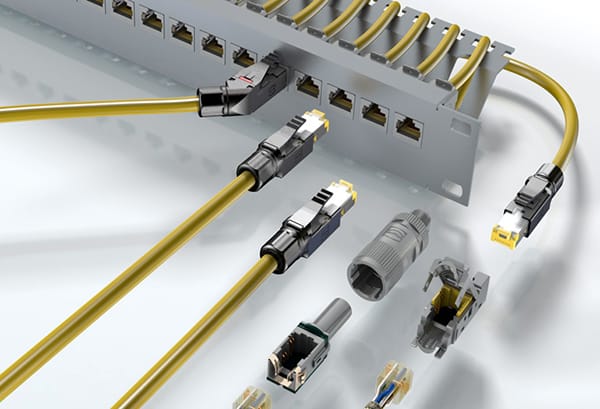
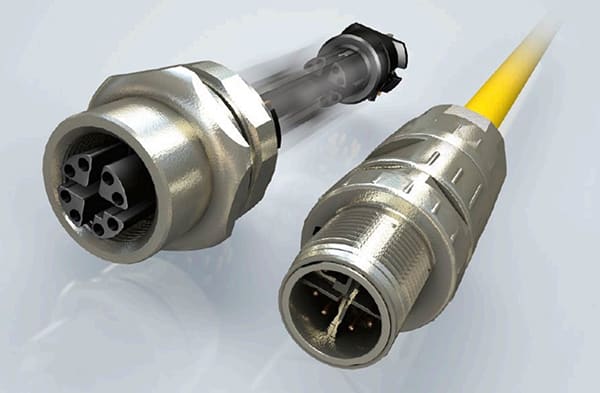
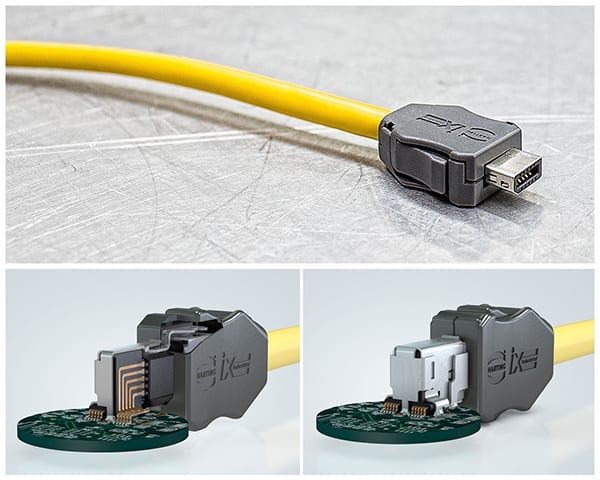
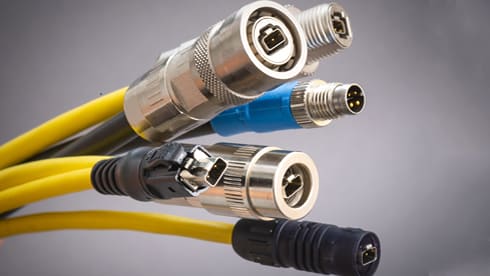
ix Industrial Connectors
Developed in response to steadily increasing demand for industrial Ethernet connectivity, HARTING’s ix Industrial connectors feature a miniature form factor with an innovative, industrial-grade contact system designed to provide a high-performance alternative to RJ45 connectors in industrial environments. The novel ix Industrial connector design was standardized in IEC 61076-3-124 in 2016 so other connector suppliers could also leverage this new technology to better serve evolving industrial market demands. ix Industrial connectors require 70% less space than standard RJ45 sockets, feature a robust metallic locking system to ensure high reliability connections in even high-vibration environments, and employ shielding to deliver improved transmission performance of up to 10Gb/s. An even newer variation, the ix Industrial PushPull connector, offers both improved handling and IP 65/67 protection. Ideal applications for ix Industrial connectors include compact Gigabit Ethernet devices and control cabinets in industrial environments.
T1 Industrial Connectors
HARTING’s T1 Industrial single-pair Ethernet (SPE) connectors are another HARTING innovation that has been standardized to encourage the development of the rugged, high-speed, and high-performance Ethernet connectivity solutions required to fully realize the promise of Industry 4.0. T1 Industrial connectors, standardized in IEC 63171-6, support Ethernet transmission with just a single pair of well-shielded twisted copper wires, which makes them much smaller, lighter, and more economical than traditional two- and four-pair solutions. They are also rated for up to 10Gb/s transmission speeds, frequencies up to 600MHz, and cable lengths up to 1,000 meters and can supply end devices with up to 50W of power via the Power over Data Line (PoDL) standard. These advantages allow T1 Industrial connectors to support field-level Ethernet infrastructure including smart sensor networks and the IIoT and, thanks to their future-proof design, are still revealing their potential in IIoT and factory automation applications.
How to Choose the Right Ethernet Connector
Choosing the right Ethernet connector for a given application can be challenging even with some knowledge about the various types of Ethernet connectors and their features, so HARTING recommends that engineers ask themselves these three simple questions to narrow down their choices.
- What speed Is required?
Or rather, what data rate does the application require? Is Fast Ethernet (an extension of the 10Mb Ethernet standard that supports up to 100Mb/s with two twisted pairs) sufficient, or is a four-pair Gigabit Ethernet solution required?
- What are the environmental requirements?
What environmental characteristics and hazards will the Ethernet connectors be subject to? Considerations include location, especially in terms of climate and space constraints, operating temperatures, and exposure to dust, dirt, liquids, chemicals, vibration, and shock.
- What are the required specifications?
Which applications will the connected device communicate with and do any industry standards apply? Depending on the application, specifications from user organizations such as the PNO for PROFINET, ODVA for Ethernet/IP, ETG for EtherCAT, and VNO for Varan could require compliance.
RS Can Help
RS has a highly experienced technical product support team that can leverage in-depth knowledge about HARTING’s product portfolio to help customers choose the right Ethernet connector for their unique application challenges and provide customized support for purchasing through to product installation.
Additional Links:
- What’s New from HARTING | RS
- HARTING’s Automation Connectivity Products | RS
- HARTING’s Industrial Ethernet Solutions and Infrastructure
- HARTING’s RJ Industrial RJ45 Ethernet Connectors
- HARTING’s M8 / M12 Circular Connectors
- HARTING’s ix Industrial Connectors
- HARTING’s “Smaller, Faster, Smarter: Ethernet Connectivity for Industrial Transportation” eBook
- HARTING’s 2020 “Single-Pair Ethernet: The Infrastructure for IIoT” eBook
- HARTING: The 4th Industrial Revolution With Single-Pair Ethernet







